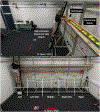Situational factors that influence overreaching on a ladder during a gutter clearing task among older adults
- PMID: 35653835
- PMCID: PMC10041861
- DOI: 10.1016/j.apergo.2022.103794
Situational factors that influence overreaching on a ladder during a gutter clearing task among older adults
Abstract
Ladder falls from overreaching are a problem in older adults. Evidence suggests ladder use behavior to be dependent on interfacing user and environmental circumstances (i.e. situational factors). This study investigates the effects of situational factors (remaining debris, ladder position, time into task, hand dominant reach, reaching disposition) on reaching during a gutter clearing task on a ladder in 104 older adults. Reaching was quantified as the maximum lateral center of pressure (COP) displacement from the ladder's center. A reach was classified as an overreach when the COP displaced outside the ladder width, indicative of a ladder tip. Reaching disposition, remaining debris, ladder position, and the interaction of reaching disposition and remaining debris predicted 20% of the reaching variability during the ladder task. Overreaching was observed in 40% of participants accounting for 13% of all extended reaches (beyond ladder). This work can guide interventions on mitigating overreaching and improving ladder safety.
Keywords: Decision making; Ladder falls; Reaching.
Copyright © 2022 Elsevier Ltd. All rights reserved.
Figures





References
-
- Organization, W.H., W.H.O. Ageing, and L.C. Unit, WHO global report on falls prevention in older age. 2008: World Health Organization.
-
- Rubenstein LZ, Falls in older people: epidemiology, risk factors and strategies for prevention. Age Ageing, 2006. 35 Suppl 2: p. ii37–ii41. - PubMed
-
- Bergen G, Stevens MR, and Burns ER, Falls and fall injuries among adults aged≥ 65 years—United States, 2014. Morbidity and Mortality Weekly Report, 2016. 65(37): p. 993–998. - PubMed
-
- Gelbard R, et al., Falls in the elderly: a modern look at an old problem. The American Journal of Surgery, 2014. 208(2): p. 249–253. - PubMed
-
- Warner KG and Demling RH, The pathophysiology of free-fall injury. Annals of Emergency Medicine, 1986. 15(9): p. 1088–1093. - PubMed
MeSH terms
Grants and funding
LinkOut - more resources
Full Text Sources
Medical

